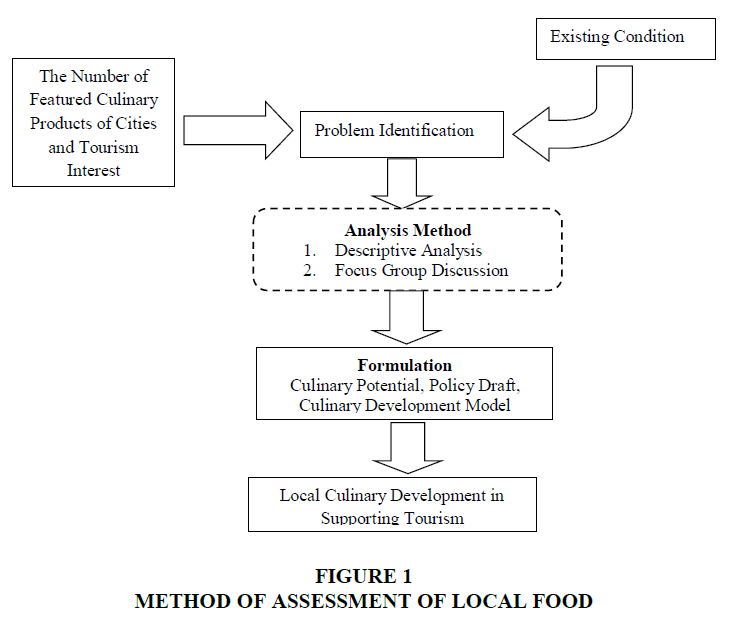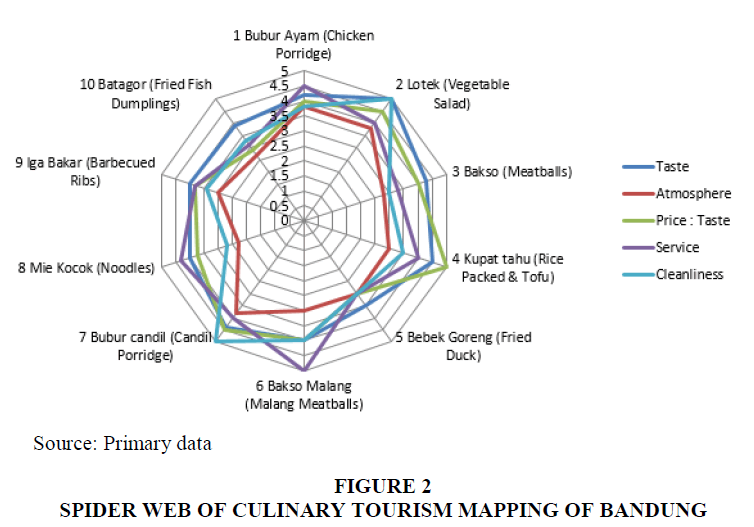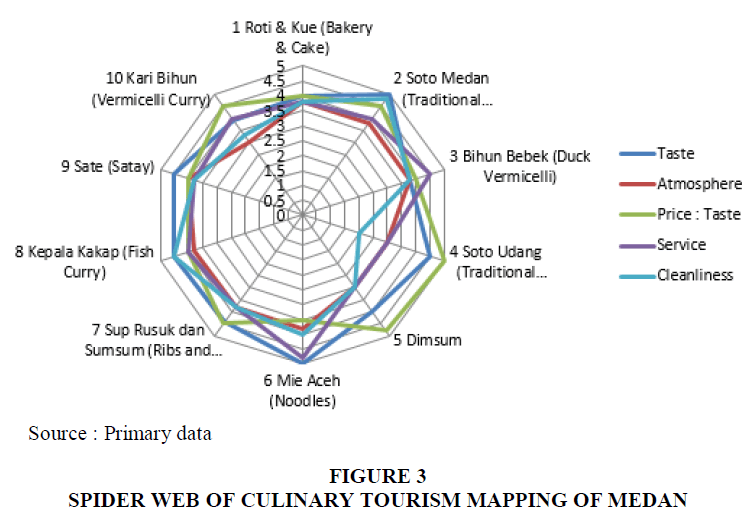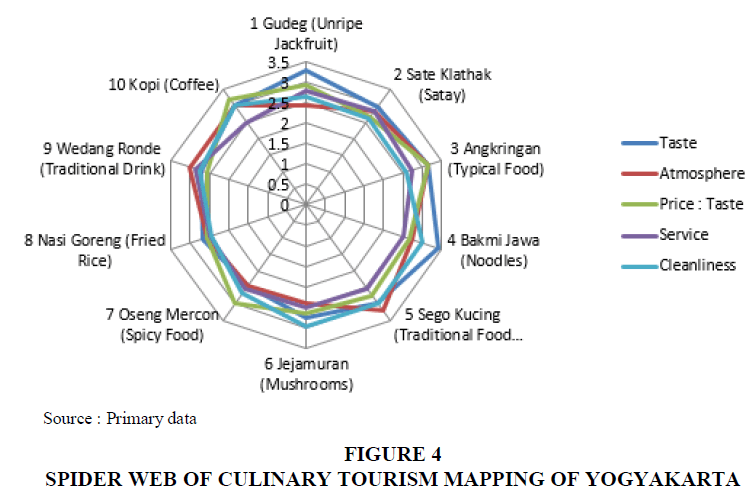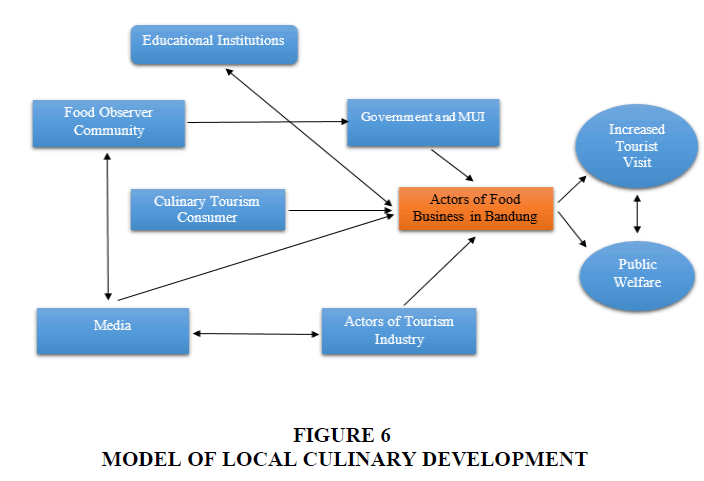Research Article: 2019 Vol: 18 Issue: 6
Culinary Development Model: Destination Attractiveness to Increase Visits
Rita Komaladewi, Universitas Padjadjaran
Asep Mulyana, Universitas Padjadjaran
Deru Indika, Universitas Padjadjaran
Merita Bernik, Universitas Padjadjaran
Abstract
Tourism is Indonesian’s mainstay factor in improving the country’s economy, since it is quite large in bringing in foreign exchange and regional income due to its unique culture and natural beauty. Optimizing tourism sector is quite effective to attract tourists to visit Indonesia. One of potential and favored tourism sectors is culinary. If this potential is developed, it will impact on the increasing entrepreneurships around, including small and medium enterprises. This is supported by other researches that a region that is able to serve and offer culinary sector can increase tourist attraction. However, with diversity of local traditional food, the role of culinary industry in general still receives less attention, and supports such as regulations are required to regulate and support the development local food. Therefore, a model integrated with government support, culinary industry, community and media is required. This research was conducted with survey method towards consumers in Bandung, Medan and Jogjakarta with total of respondents 360, as well as conducting focus group discussionwith culinary entrepreneurs, tourism department, and MUI (Indonesian Ulema Council). From the result, an integrated model was obtained in increase the number of tourists and will increase the small and medium enterprises that support the national economy.
Keywords
Tourism, Local Culinary, Enterprises, Integration.
Introduction
Based on the government’s appeal, the tourism sector must be promoted more intensively because currently tourism is a leading sector that contributes greatly to the Indonesia’s economy improvement. One of its great contributions for the economy improvement is from the real sector, which is food industry. It is a great opportunity for culinary industry because today, food is not only a primary need but also becomes people’s lifestyle to relax their recreational need in culinary hunting. This is supported by the data that food and beverage industry is the largest contributor of Gross Domestic Product (GDP) for the non-oil and gas industry category in Indonesia (Kemenperin, 2016). Seen from creative industry point of view, culinary industry contributes the largest portion toward the creative industry development after the craft and fashion industries (Research & Education, 2017). This supports a program by Tourism Department that which optimizes favorite destinations that can attract many tourists.
Several cities referred to by the government as favorite destinations are competing to utilize this opportunities. These cities have various superior products particularly local food that becomes a part of government’s agenda to be developed to welcome tourists. Culinary tourism is totally different with other kinds of tourism in general because culinary tourism is more favoring food, taste satisfaction and distinctiveness of a food or a dish (Okech, 2014). There are various kinds of culinary industry, ranging from restaurant business that include both product and service elements, to creation that focuses on processed food and beverages that can become specialties of a region. If focusing only on processed food and beverages, then each product must have attributes attached to it. Cities of Bandung, Medan and Jogjakarta are tourism destinations that are referred by Ministry of Tourism, whereas tourists who come to these cities can visit more than once. This is allegedly because the local food is really famous and favored, so tourists often return because they miss the local food. However, what is still yet to know: 1) how is the culinary potential of Bandung, Medan and Jogjakarta cities? In addition, regional government role needs to be addressed in supporting the efforts of Ministry of Tourism to appeal to culinary tourism which has potential to contribute to regional income. 2) what kind of regulations that should be design as a form of government support to the development of local food, or also localizing culinary areas that will potentially be the main tourist attraction of the cities and etcetera. 3) how is the culinary development model that supports tourism which considers integration from various parties?
Literature Review
Based on a research by Komaladewi et al. (2017), tourist who visit Bandung generally return to Bandung because of its satisfying food, for example are the attractiveness of food serving and taste of the food that cause them to missBandung. In addition, it is also stated that fast service is very important, not only the taste and serving, but also parking facility also encourage people to be willing to visit Bandung. Sukenti (2014), Indonesia’s gastronomy with all its diversity and uniqueness is one of the potential tourist attraction that can support the tourism sector. Sims (2009) stated that local food is an experience that must be felt by consumers to indulge their tongue. In addition, Lynn et al. (2017) stated that in general tourists look for local original food to taste that represents its area as an unforgettable experience. Baltescu (2016) stated that local food can become tourist attraction because of its distinctiveness and uniqueness of the food itself.
Menrad (2003) argued, his research shows that the food sought by consumers have categories: 1. Appearance. 2. Freshness and 3. Health. Several categories become stimuli for consumers to make decision in selecting food. Consumers who are satisfied after consuming the food will easily share the information to public, so that the process of word of mouth communicationcan run well. On the other hand, Al Yousuf et al. (2015) stated that government must support regulations particularly in food industry, because in a larger scale, there might be food that are not hygienic and harmful so that consumers might be worried about food security. Therefore, government should be proactive in food protection regulation called Food Safety Management System. Government issues safety foodregulation to provide consumer protection and ensure that all food during production, handling, storage, processing and distribution are safe, healthy, and suitable for human consumption; in accordance to safety and quality requirements; and honestly and accurately labeled as regulated by law.
Chaney & Ryan (2012) proposed that tourists will eat in tourism objects that they visit and it will pose a great impact on the assessment of the destinations. Diverse choices for dining can become a choice for vacation. In tourism, both local and international cuisines are usually used as branding to support existing identity. According to Zsarnoczky (2018) “the culinary essence of a nation” attracts both domestic and international tourist. Ideally, tourists, professional tourism, and local people should equally satisfy with local culinary culture. The success of local culinary culture is proven when local people consume similar food with those offered to tourists.
Methodology
Analysis conducted in this study used was conducted through 1) Spider Web Chart in determining culinary tourism potential map 2) Focus Group Discussion (FGD) with culinary experts, culinary businessmen and several consumers (Figure 1). The use of these approaches as basis of the determination of policy draft was finalized by development model. This research was conducted with survey method towards consumers in Bandung, Medan and Yogyakarta with total of respondents 360 (observation were conduct toward 30 restaurants from 3 cities), as well as conducting focus group discussionwith culinary entrepreneurs, tourism department, and MUI (Indonesian Ulema Council). It was determining local culinary potential map in each city using spider web chart. The spider chart, also called radar chart, web chart, polar chart, and star plots, is named by its special appearance. It is a chart that uses two dimensional graph to display multi-dimensional data structure (Meyer, 2012).
Results
Here are the results of the primary data based on the choice of consumers visiting the restaurants of Bandung, Medan dan Jogjakarta.
Map of the Potential Strength of Local Culinary Products of Bandung
It can be seen in Table 1 & Figure 2 that the most potential aspects of Bandung culinary from the five variables are taste and price. The excellent and unique taste makes Bandung culinary well recognized and accepted by customers from many places. Besides, its price is affordable for most people. The price is considered reasonable and comparable to its taste. Bandung culinary carries creativity and innovation by maintaining its taste and local wisdom.
| Table 1 The Culinary Parameter at Bandung City | ||||||
| Parameter | ||||||
| No | Culinary name | Taste | Atmosphere | Price | Service | Cleanliness |
| 1 | Buburayampelana | 4.2 | 3.8 | 4 | 4.5 | 3.8 |
| 2 | Lotek kalipah apo | 5 | 3.8 | 4.5 | 4 | 5 |
| 3 | Bakso semar | 4.3 | 2.8 | 4 | 3.3 | 3 |
| 4 | Kupat tahu gempol | 4.5 | 3 | 5 | 4 | 3.5 |
| 5 | Bebek Goreng om aris | 3.5 | 3 | 3 | 3 | 3 |
| 6 | Bakso Malang enggal | 4 | 3 | 4 | 5 | 4 |
| 7 | Bubur candil | 4.4 | 3.8 | 4.5 | 4 | 5 |
| 8 | Mie kocok dadeng | 4 | 2.3 | 3.7 | 4.3 | 2.7 |
| 9 | Iga bakar sijangkung | 4 | 3 | 3.8 | 3.8 | 3.4 |
| 10 | Batagor kingsle | 3.9 | 2.7 | 2.9 | 3.1 | 3.3 |
| Average | 4.18 | 3.12 | 3.94 | 3.90 | 3.67 | |
Map of the Potential Strength of Local Culinary Products of Medan City
Medan culinary also has similar potentials as Bandung culinary, namely in terms of taste and price. Most visitors love Medan culinary due to its strong taste made from traditional spices. The visitors consider that the price is comparable to its taste, and many of them do not consider price as a problem for enjoying Medan culinary. Owners’ creativity of Medan culinary contributes to the repeat visits of the customers (Table 2 & Figure 3).
| Table 2 The Culinary Parameter at Medan City | ||||||
| Parameter | ||||||
| No | Culinary name | Taste | Atmosphere | Price | Service | Cleanliness |
| 1 | Kepala Kakap Jumedi | 4.0 | 3.8 | 4.0 | 3.8 | 3.8 |
| 2 | Nelayan Dimsum | 5.0 | 3.8 | 4.5 | 4.0 | 4.8 |
| 3 | Mie Aceh Titi Bobrok | 3.8 | 3.8 | 4.0 | 4.5 | 3.8 |
| 4 | Soto medan sinar pagi | 4.5 | 3.0 | 5.0 | 3.0 | 2.0 |
| 5 | Soto medan kesawan | 4.0 | 3.0 | 4.8 | 3.0 | 3.0 |
| 6 | Bihun Bebek Asie (Kumango) | 5.0 | 3.8 | 3.5 | 4.8 | 4.0 |
| 7 | Rumah Makan Sipirok | 4.4 | 3.8 | 4.5 | 3.8 | 3.8 |
| 8 | TipTop | 4.5 | 3.8 | 4.0 | 4.0 | 4.5 |
| 9 | Sate memeng | 4.5 | 4.0 | 4.0 | 3.8 | 3.8 |
| 10 | RM. Tabona | 3.9 | 3.0 | 4.5 | 4 | 3.3 |
| Average | 4.36 | 3.49 | 4.28 | 3.87 | 3.68 | |
Map of the Potential Strength of Local Culinary Products of Jogjakarta City
Although lower than Bandung and Medan culinary, Yogyakarta culinary’s score is still relatively high in terms of taste and price shown in Table 3 & Figure 4. Yogyakarta culinary is well-known for its affordability and good taste. Amidst the growing number of modern restaurants and cafés, the traditional culinary of Yogyakarta survives till nowadays with its authentic taste and manages to compete with new modern culinary.
| Table 3 The Culinary Parameter at Jogjakarta City | ||||||
| Parameter | ||||||
| No | Culinary name | Taste | Atmosphere | Price | Service | Cleanliness |
| 1 | Gudeg | 4.5 | 3.0 | 3.5 | 3.0 | 3.0 |
| 2 | Sate Klatak | 3.5 | 2.8 | 3.5 | 3.0 | 2.8 |
| 3 | Angkringan | 3.8 | 3.8 | 4 | 2.5 | 2.8 |
| 4 | Bakmi Jawa | 5 | 3 | 3.5 | 3.0 | 3.5 |
| 5 | Sego Kucing | 3 | 3.5 | 3.8 | 3.0 | 3.0 |
| 6 | Jejamuran | 3.3 | 3.0 | 3.5 | 2.8 | 3.5 |
| 7 | Oseng Mercon | 3 | 2.5 | 4.0 | 2.8 | 2.8 |
| 8 | Nasi Goreng | 3 | 2.5 | 2.8 | 3.0 | 2.5 |
| 9 | Wedang Rondhe | 4.0 | 3.8 | 2.8 | 3.5 | 3.3 |
| 10 | Kopi | 3.5 | 3 | 3.5 | 3.0 | 3.3 |
| Average | 4.00 | 3.09 | 3.49 | 2.96 | 3.05 | |
From the three spiderwebs (Figures 2-4) of culinary tourism shown earlier, it is clear that the culinary from Bandung, Medan, and Yogyakarta emphasizes the regional taste for attracting tourists.
Using the five categories, namely taste, atmosphere, price, service, and cleanliness, we found that each city in this study has its uniqueness, strengths, and weaknesses. In terms of taste, in Table 4, Bandung culinary has a high score of 4.18, represented by Lotek (vegetable salad). Lotek has a unique taste which is different from other Lotek from outside Bandung. This Bandung culinary is the most legendary culinary using the recipe from the previous generations. Medan culinary has an average taste score of 4.36, represented by Soto Medan, which is notably different. Yogyakartaculinary has an average taste score of 4.0, represented by Gudeg. Yogyakarta culinaryis mostly categorized as classical ones.
| Table 4 The Average of the Culinary Parameter of Bandung, Medan & Jogjakarta | ||||||
| Parameter | ||||||
| No | Culinary name | Taste | Atmosphere | Price | Service | Cleanliness |
| 1 | Bandung | 4.18 | 3.12 | 3.94 | 3.90 | 3.67 |
| 2 | Medan | 4.36 | 3.49 | 4.28 | 3.87 | 3.68 |
| 3 | Jogjakarta | 4.00 | 3.09 | 3.49 | 2.96 | 3.05 |
In terms of atmosphere, culinary in the three cities in this study is satisfactory because it carries the concept of street food, not cafés, which create an atmosphere allowing customers to stay longer. In terms of price, Yogyakarta culinaryis the lowest (3.09) compared to Bandung and Medan culinary. While Bandung culinaryis in the second position since the price is relatively affordable (3.94), especially for the market-dominating college students with middle purchasing power. Medan culinaryis the most expensive one (4.28), represented by Soto Udang and Dimsum. Indeed, people’s purchasing power and per-capita income in Medan are relatively higher than Bandung and Yogyakarta.
Regarding the service, the first positioned belongs to Bandung culinary, represented by Baso Malang Enggal, having a café design with ample space and many servants, allowing to serve a vast number of customers. Customers are also warmly welcomed by the café. Hospitality is indeed an integral aspect of West Java culture.
Based on the facility, Medan culinary supports the customers with sufficient facilities which are reachable (3.87), for example, customers can find Bihun Bebek Asie restaurant in several locations in Medan while the service of restaurants in Medan is not as good as in Bandung.
The service quality of Yogyakarta culinary (2.96) is the poorest among the three cities. It is caused by a large number of visitors, street food concept, less space, and hectic servants, making them unable to control the quality of service and taste. The street food concept of Yogyakarta culinary results in the low cleanliness (3.09), which becomes the lowest score among the three cities because such concept makes cleanliness more challenging to control.
Based on 5 variables from the three cities on Table 4 and Figure 5, it shows that Medan is superior to Bandung and Jogjakarta. This is because Medan has a distinctive taste and has a unique taste found in herbs used in local cuisine. Medan local cuisine uses a lot of spices that are more diverse than in Bandung and Jogjakarta.
However, the development of local culinary potential of each city lacks of full support from government, for example location, parking, garbage disposal, hygienic food, and development of culinary renewal are all done alone, whereas guest arrival contributes to the local revenue for each of these regions. Therefore, the government givers more attention in the form of support, namely regulations that can increase the existense of restaurants and culinary development which support the cultural preservation of the area that can be packaged in a tourism package.
Based on the result of Focus Group Discussion (FGD) attended by Bandung City Tourism Office, daily media, culinary enterprises of Bandung City, MUI as Halal Centreas well as research team, a culinary policy plan was formulation that can be presented as a draft of Culinary Policy that can support tourism, including:
1. Policy on the Culinary Business Permit (Restaurants), through Standardization of business locations, is issued by the regional government. The business permit policy for restaurants is governed by regional regulations according to the location of the business. Tourism business services must have a Tourism Business Registration Certificate (TDUP) as a business operational permit.
2. Policy on the Business Operational Standards Policy (Restaurants/Diners), through business operational standardization, must have marketing licenses issued by the Food and Drug Supervisory Agency (BPOM). For processed food products produced by home industries, marketing authorization is sufficient in the form of a Household Industrial Food Production Certificate (SPPIRT) issued by the Regency/City Health Office. Certification with a halal guarantee system.
3. Policy on the Business Service Standards (Restaurants/Diners), Standardization of business services, there are rules regarding the standardization of restaurant and diner hygiene regulated by the Decree of the Minister of Health of the Republic of Indonesia Number 1098 in 2003. This regulation regulates the requirements for hygiene of diners and restaurants to protect the public from food and beverages that do not meet the requirements. SOP to be created in each restaurant, then based on the results of the Focus Group and discussions with related parties, a draft policy was made which is expected to be able to help local governments, culinary entrepreneurs and consumers, draft policies as follows :
4. Policy on the development of the quality and quantity of creative people in the local culinary field, by identifying competency standards for developing competency standards and labor certification in the culinary field, facilitating the empowerment of cooks to improve the ability to process traditional regional culinary delicacies.
5. Policy on the Development of Street Vendors Culinary Areas (PKL) in Bandung, by determining the area/container for culinary PKL, local content of culinary night, where local governments support infrastructure in the region by preparing clean water and proper toilets for visitors. Business legality of PKL (having NPWP/Tax Identification N) and bank account, cleaning SOP, Service SOP.
6. The Policy for the Culinary Industry Development Supporting Institutions in Bandung, by harmonizing regulations including synergy, coordination, and collaboration between parties (tourism agencies, small and medium enterprises, culinary businesses, and communities in developing Culinary West Java) and cooperating in various events culinary.
7. Policy to facilitate the quality of local culinary products, namely to increase quality standards gradually
With the regulations, a model can be obtained that shows the integration of several parties which can support Indonesian local cuisines.
For cuisines of Medan and Bandung, first, they have the superiority of taste because the cuisines offered are so diverse, rich in seasonings and spices that are liked by the tongue of culinary lovers. Second, the price is regarded to be in accordance with the taste offered, even though not all cuisines in Medan, Bandung, Jogjakarta have cheap prices but the quality of the taste is valued according to how much the cost that visitors spend to enjoy these culinary delights. Third, the service aspect is equally considered by culinary providers in Bandung and Medan so that visitors do not have to take longer time to enjoy these culinary delights. Fourth, the cleanliness can still be regarded as enough. Fifth, in terms of the atmosphere, this indicates the atmosphere that was built is still considered less of a priority. Then the fourth one is friendly service from culinary providers to the visitors, and fifth, unfortunately cleanliness still has to be considered by culinary businesses in the city of Yogyakarta. So, Bandung's leading local culinary map is Lotek, for Medan is Soto Medan and Jogjakarta is Gudeg. Surely, these authentic foods will lead these cities to have a unique positioning in local cuisines. In other words, they become a potential attraction for domestic and foreign tourists. At present, the entrepreneurs need to be supported by regulations that strongly support the development of local food and infrastructure assistance. These regulations and policies are related to parking regulations, clean water, local culinary development, hygiene, and service issues that will enhance competitiveness so as to bring many benefits to the local government. Small and medium enterprises must take this opportunity, so that it is in line with the government's program on employment. The media must be involved because it is able to shape the people's awareness through positive reporting. In addition, the culinary community as an observer needs to be given attention as a control of culinary development. Educational institutions have a big role in realizing the culinary industry that has values, so that it has a competitive advantage. Furthermore, the government and MUI must synergize in determining regulations which can improve culinary productivity with the support of infrastructure, a good standard operating procedure so that Indonesian local cuisines have a high value, the government plays a role in controlling cleanliness and food feasibility from upstream to downstream, so food it is not only delicious on the tongue but has a high value so it is able to maintain the interests of consumers well. Thus the following model is designed:
Based on the design of the model, a benefit was obtained that to increase tourist visit, which will certainly increase public welfare, supports are required from various parties, namely educational institutions, government and MUI which will become the fortress in supporting culinary tourism (Figure 6). Consumers and food observers will become driving factor through word of mouth or viral communication. Actors of tourismindustry do not only include the food industry itself, but also hotels and other entertainment tourism objects that will become partners in developing the local culinary industry. Media is a strategic partner that can educate society regarding the existence of local food that will attract both local and international tourists to visit. By cooperating with Department of Cooperatives and SMEs (KUKM), it is expected that local culinary (not just diners and restaurants), namely street vendors that have great potential and are in demand by tourists, will also improve the regional economy and empower SMEs on an ongoing basis.
Regarding the policies built by the government, it is nothing but standardization of business locations regulated and issued by the regional government. Regulations or policies of each region can vary according to the conditions of the region. The standard of service is that it will curb all culinary potentials whose standards are maintained because they have potential values. It is expected that with the existence of a clear and explicit SOP from the local government, culinary providers are not only focused on gaining profit, but they are also required to provide the best service to their customers so that they can make a good image. Policies related to identification of competency standards, development of competency standards and labor certification in the culinary field and facilitating the empowerment of cooks to improve the ability to process traditional culinary. So, it is expected that with these policies, culinary providers will have good competency standards in order to be able to compete, not only in their own area but also with other cities that offer culinary tourism. With this competency, it is also able to make local culinary quality competitive. In addition, the policies made must be able to encourage good collaboration between related parties such as the tourism agency, food service, culinary business, and the community in developing the culinary industry. With this policy, it is able to empower a variety of culinary products that are sold by culinary providers as well as involving them in culinary events, so that our cuisines are getting more recognition by food lovers and become famous to foreign countries.
Conclusions
This model of culinary development was supported by several parties who will support in increasing the number of tourists to increase tourist visit, which will certainly improve people’s welfare. Therefore, seriousness is needed to realize an integrated culinary development model where educational institutions, government, and MUI will become the fortress in creating regulations in supporting the culinary industry. Tourism industry does not only include culinary industry, but also hotels as well as other entertainment tourism objects which will become partners in building local culinary industry, so that it is hoped in the future that there will be advantageous collaboration between all parties.
The draft policy that supports this culinary industry sector focuses more on the gradual improvement of quality standard for culinary providers who offer local culinary dishes. It is hoped that with this policy, the quality of local culinary products can continue to be maintained with continuous improvementconcept so that they become timeless.
Acknowledgement
This research was funded by Ministry of Research and Technology, with the aim to help developing Indonesian tourism which can bring great foreign exchange for the country.
References
- Al Yousuf, M., Taylor, E., & Taylor, J. (2015). Developing a government strategy to meet international standards of food safety across the hospitality industry. Worldwide Hospitality and Tourism Themes, 7(1), 4-16.
- Baltescu, C.A. (2016). Culinary experiences as a key tourism attraction. Case Study: Brasov County. Bulletin of the Transilvania University of Brasov. Economic Sciences. Series V, 9(2), 107.
- Chaney, S., & Ryan, C. (2012). Analyzing the evolution of Singapore's World Gourmet Summit: An example of gastronomic tourism. International Journal of Hospitality Management, 31(2), 309-318.
- Komaladewi, R., Mulyana, A., & Jatnika, D. (2017). The representation of culinary experience as the future of indonesian tourism cases in Bandung City, West Java. International Journal of Business and Economic Affairs, 2(5), 268-275.
- Lynn, I., Chen, L., Scott, N., & Benckendorff, P. (2017). Mindful tourist experiences: A Buddhist perspective. Annals of Tourism Research, 64, 1-12.
- Menrad, K. (2003). Market and marketing of functional food in Europe. Journal of Food Engineering, 56(2-3), 181-188.
- Meyer, W.J. (2012). Concepts of mathematical modeling. Courier Corporation.
- Okech, R.N. (2014). Developing culinary tourism: The role of food as a cultural heritage in Kenya. In Proceedings of the Second International Conference on Global Business, Economics, Finance and Social Sciences.
- Research, D., & Education, P.E.K.D.R. (2017). Statistical data and results of the creative economy survey collaboration between the creative economy agency and the central statistics agency.
- Sims, R. (2009). Food, place and authenticity: Local food and the sustainable tourism experience. Journal of sustainable tourism, 17(3), 321-336.
- Sukenti, K. (2014). Gastronomy tourism in several neighbor countries of Indonesia: A brief review. Journal of Indonesian Tourism and Development Studies, 2(2), 55-63.
- Zsarnoczky, M. (2018). Novel concepts in the health tourism industry. Vadyba, 32(1), 67-73.
